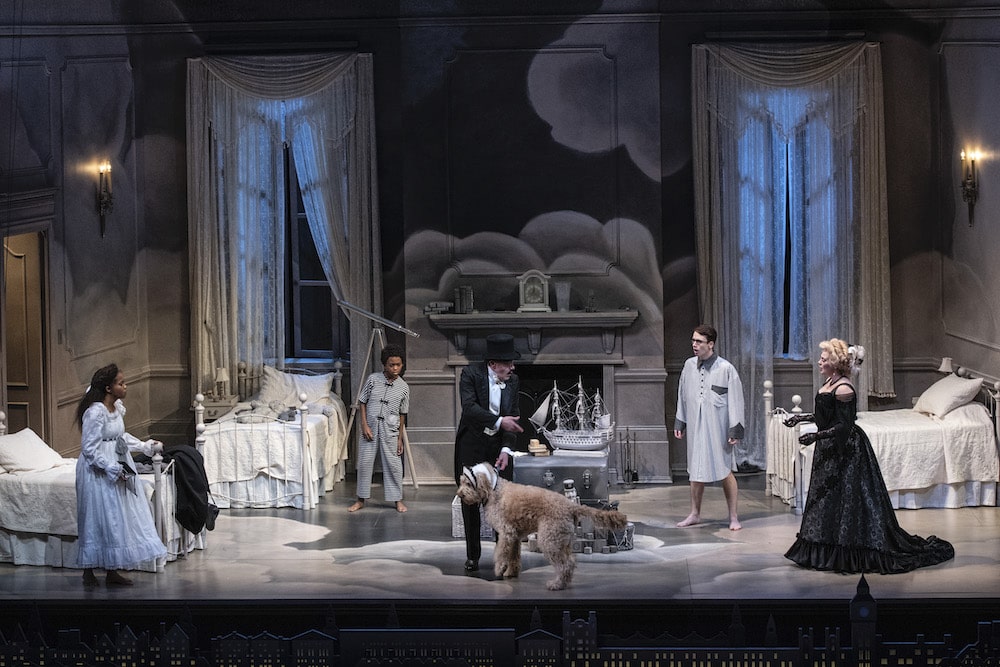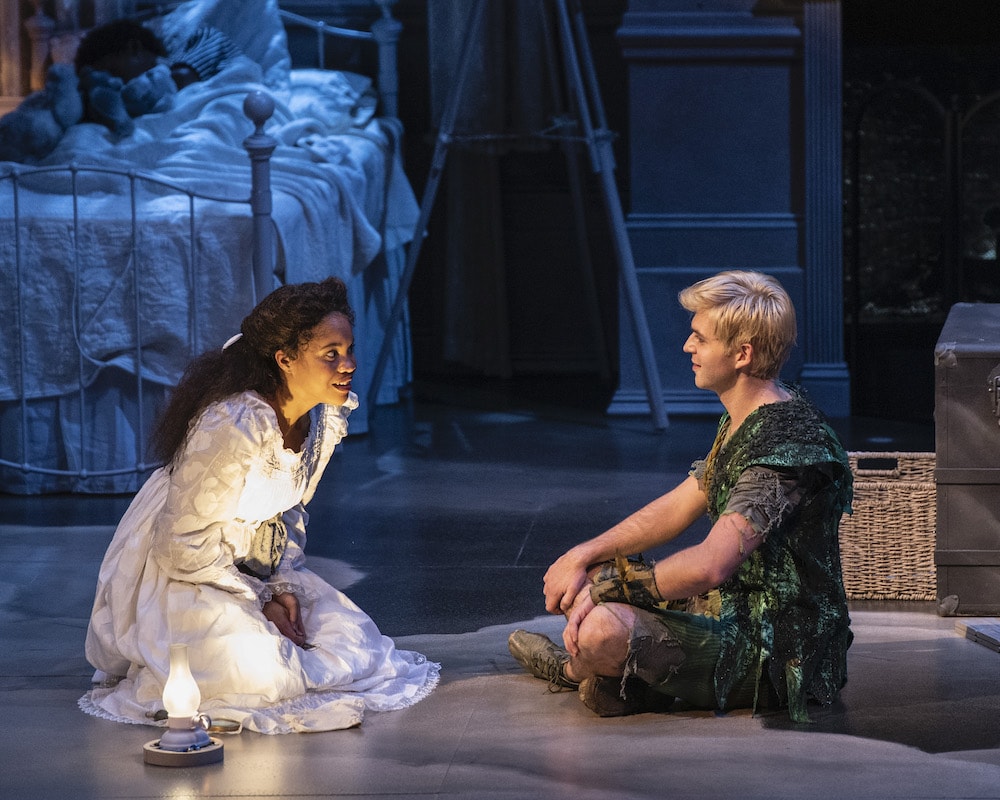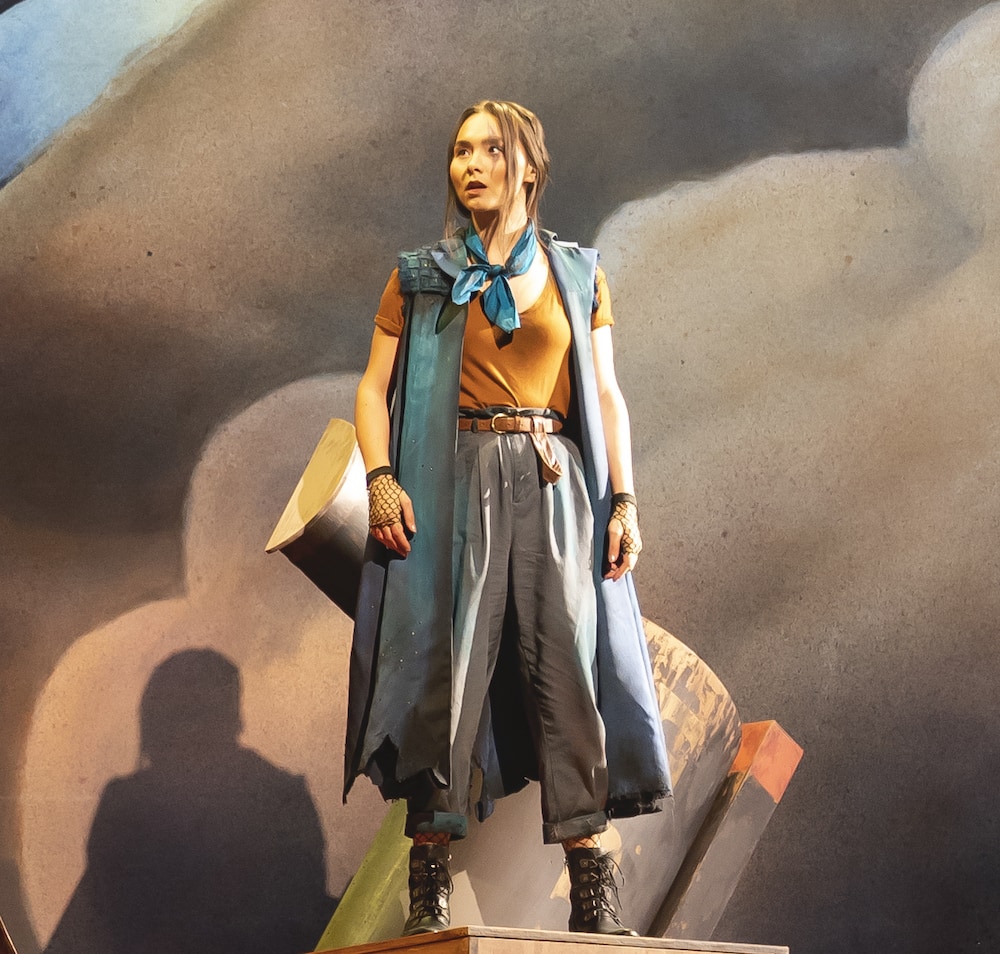J. M. Barrie imagined a lot when he wrote his 1904 play about the boy who wouldn’t grow up, but he could not have imagined how many childhoods have been etched by its enchantment. Now in Peter Pan and Wendy, Lauren Gunderson has looked at the classic tale through a lens that can see what daughters and sons face growing up today.

In the majestically magical production now playing at Shakespeare Theater Company, all the dreamlike wonder remains—the flying and adventures, the fairies and pirates, the canine nanny and crocodile. It is absolutely a show for all ages. Peals of intergenerational laughter greet the performance throughout, and now and then there’s that delighted sound of just the children cracking up. As in the best of Disney, there are simultaneous appreciation channels, one for kids and one for grownups. What Gunderson has done in Peter Pan and Wendy, though, goes Disney one better: she has not shied from what can be known now about patriarchy and colonialism, which under Alan Paul’s inspired direction has resulted in a marvelous amalgam of awesome spectacle and mindful meaning.
In Gunderson’s beguiling retelling, Wendy joins Peter Pan as a co-hero of the story, and later a third hero emerges, Tiger Lily, reconceived as a Native rights activist.
The fresh feminist spin begins with Wendy (a wonderfully resolute Sinclair Daniel) as an up-and-coming astronomer. Peering out the window at the nighttime sky through her telescope in the gray-on-gray nursery (Jason Sherwood did the applause-worthy scenic design), Wendy espies an odd star (which will turn out to be Tinkerbell en route). Emboldened by Marie Curie’s Nobel Prize for discovering radium, Wendy then explains to her conventional mother, Mrs. Darling (a prim and proper Jenni Barber who will double hilariously as a mean-girl Tinkerbell), why she wants to go to science school instead of to finishing school as her parents insist.
It’s bedtime and Wendy’s two brothers traipse in, John (an enjoyable Christopher Flaim) and Michael (an adorable Chauncey Chestnut). The first hint that Gunderson is about to take on patriarchy’s debilitating effects on boys comes when young John in his nightgown takes a ridiculous stance of “bravado” to impress his stern father, Mr. Darling (an imperious Derek Smith who will become hilariously dastardly as Captain Hook).
The children’s nanny, the pet dog named Nana (an affably affectionate Bailey, trained by William Berloni), shows up to steal some scenes. Mrs. Darling sings the children a lovely lullaby. Mr. and Mrs. Darling go out for the evening, thinking the kids are sound asleep. But who should suddenly enter through the window but Peter Pan, in search of his personal fairy Tinkerbell, a sprightly light flitting about.
Gunderson has given the character of Peter a complexity that the remarkably versatile Justin Mark reveals as the play proceeds—charmer, trickster, fighter, cad, then ultimately an ally of both Wendy and Tiger Lily. He starts out all boy, intent on having fun, focused on finding his lost shadow, which here is a tipoff to what will emerge as his self-centeredness—about which he will be challenged by both Wendy and Tiger Lily. For now, Peter and Wendy meet cute. He graciously thanks her for reattaching his shadow—though only after taking all the credit for himself and being called on it by Wendy. In the original Wendy offers to give Peter a kiss. In Gunderson’s rethink, Wendy offers to give him a piece of advice. It’s a funny moment, and it shows Wendy already becoming for Peter a respected role model.

The effect when Peter takes Wendy, John, and Michael flying to Neverland is stunning (Paul Rubin choreographed these aerial sequences). The nursery recedes in stars and darkness (Isabella Byrd did the enthralling lighting design), and suddenly we are on an island of Lost Boys and oversize toys. It’s no spoiler to mention that everything after the parents’ departure is the collective dream of three precocious siblings. The surprise is the intriguing way that dramatic fact is carried through in this production. The colorful Neverland set appears first in the nursery in gray miniature. Hook and Tinkerbell are played by the same actors who play the father and mother. The blood-red pirate ship in Act Two is also first seen in the nursery as a gray scale model.
Once in Neverland, we meet Tiger Lily, the stalwart survivor of a proud people who lived there first. In Isabella Star LaBlanc’s radiant performance, Tiger Lily will show herself to be fearlessly brave and fiercely feminist, but for now she is whispering endearments to her pet, an enormous crocodile (a puppet designed by James Ortiz so big it stretches from jaws stage left to tail stage right, with a fearfully cavernous growl by sound designer John Gromada).

We are next introduced to the Lost Boys, a ragtag bunch of beach urchins divertingly played by Francisco Gonzalez, Ronen Lewis, Joriah Kwame, Darren Alford, and Tendo Nsubuga. Peter rescued them because they too refused to grow up, and they live underground for safety because a motley crew of dimwitted Pirates (a comic trio of Michael Glenn, Calvin McCullough, Gregory Wooddell) is out to capture Peter so Captain Hook can kill him.
The vengeful Captain as in the original wears a hook where he lost a hand when Peter cut it off and fed it to the croc that also swallowed a clock. Garbed like a high-camp dandy (Loren Shaw did the show’s ceaselessly fanciful costumes), Hook turns out in Gunderson’s witty take to be half of a standup duo with his lackey Smee (played with impeccable comic timing by Tom Story), whose sycophancy scarcely veils his more-than-bromantic feelings for Hook.

Tink is possessive of Peter, can’t tolerate any other girls on the island, and skips no opportunity to sabotage Wendy. In one of Gunderson’s many twists of genius there comes a furious tiff between Wendy and Tinkerbell. Gunderson has Tiger Lily break it up and tell them
TIGER LILY: ALRIGHT THAT’S ENOUGH. Don’t you understand how utterly useless it is for girls to go against girls? The world’s hard enough on us and then you turn on each other? Come on…. You’re both better and smarter than this… You’re only hurting yourself.
Not long after, they’re shouting together “Girl power!”

Gunderson gives Tiger Lily some of the sharpest insights in the play. For instance, when the characters discuss that Neverland is a dreamland, one Lost Boy wishes for “less pirates and more unicorns” but Tiger Lily counters: “I’d start with less colonial genocide.”And this, after Hook sets fire to the Lost Boys’ underground living quarters:
TIGER LILY: Well he [Hook] destroyed my people. No. This place is built for you, and your fun and that apparently means we all suffer…. My dream would be peace and family and crocodiles, but this? This is all boys and battle and I’m done.
In another scene directly from Gunderson’s imagination. Peter and Hook have a confrontation in which a savvy Hook points out how much he and Peter have in common, and how close Peter is to becoming Hook himself. Peter denies this vehemently. But as Gunderson crafts Peter’s fascinatingly layered character arc, he grows into understandings by listening to Wendy and Tiger Lily that change him in extraordinary ways. As much as Wendy and Tiger Lily have been reconceived, it is actually Peter Pan whose character is most transformed.
There is so much incandescent brilliance in this script and this superentertaining production, it makes one wish that all resuscitated classics were even half as smart. And it makes one hope that this will be the version future generations come to know and love and learn from.
CAST
REAL WORLD
Wendy Darling: Sinclair Danie; Mrs. Darling: Jenni Barber; John Darling: Christopher Flaim; Michael Darling: Chauncey Chestnut; Mr. Darling: Derek Smith; Nana: Bailey
NEVERLAND
Peter Pan: Justin Mark; Tinkerbell: Jenni Barber; Tiger Lily: Isabella Star LaBlanc; Tootles: Francisco Gonzalez; Curly: Ronen Lewis; Slightly: Joriah Kwame; Twin: Darren Alford; Twin: Tendo Nsubuga
PIRATES
Captain Hook: Derek Smith; Smee: Tom Story; Jukes: Michael Glenn; Noodler: Calvin McCullough; Starkey: Gregory Wooddell; Ensemble: Oliver Archibald, Megan Huynh, Joseph Respicio; Fight Captain: Gregory Wooddell
PRODUCTION CREDITS
A play by J.M. Barrie
Adapted by Lauren Gunderson
Directed by Alan Paul
Composer: Jenny Giering; Scenic Designer: Jason Sherwood; Costume Designer: Loren Shaw; Lighting Designer: Isabella Byrd; Sound Designer: John Gromada; Projection Designer: Jared Mezzocchi; Puppet Designer: James Ortiz; Flying Sequences Choreographed by Paul Rubin; Fight Choreographer: David Leong; Choreographer: Katie Spelman; Special Effects: Jeremy Chernick; Animals Trained by William Berloni; New York Casting: Laura Stanczyk, CSA; Resident Casting Director: Carter Wooddell; Dramaturg: Drew Lichtenberg; Voice and Text Coach: Lisa Beley; Assistant Director: Madeleine Smith; Production Stage Manager: Joseph Smelser; Stage Manager: Christopher Michael Borg; Assistant Stage Manager: Rebecca Shipman
Running Time: Two hours and 10 minutes. including one 15-minute intermission.
Peter Pan and Wendy plays through January 12, 2020, at Shakespeare Theatre Company’s Sydney Harman Hall – 610 F Street NW, in Washington, DC. For tickets, call the box office at (202) 547-1122 or go online.
READ “Isabella Star LaBlanc, who plays Tiger Lily in ‘Peter Pan and Wendy’ at Shakespeare Theatre Company, on why Native stories matter.” Interview by John Stoltenberg.
READ “Playwright Lauren Gunderson had one stipulation when reworking ‘Peter Pan.’ The sexism and racism had to go.” Interview by Nicole Hertvik.
READ “Shakespeare Theatre Company’s Simon Godwin on conscience in ‘Everybody’ and himself.” Interview by John Stoltenberg.




